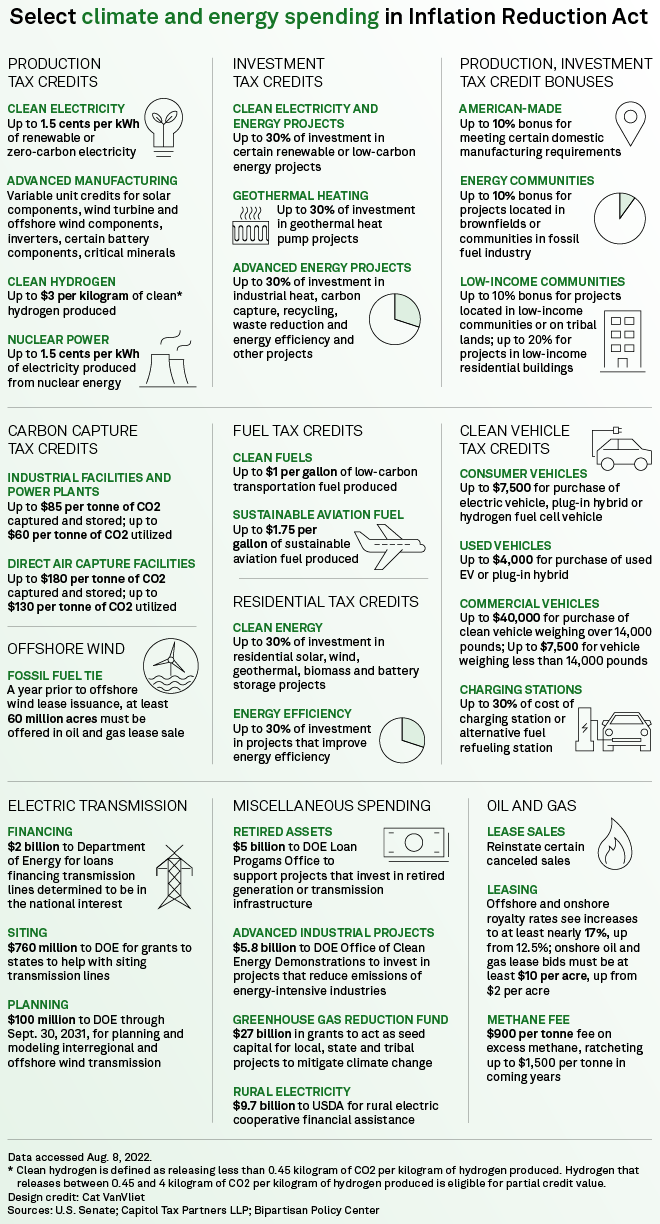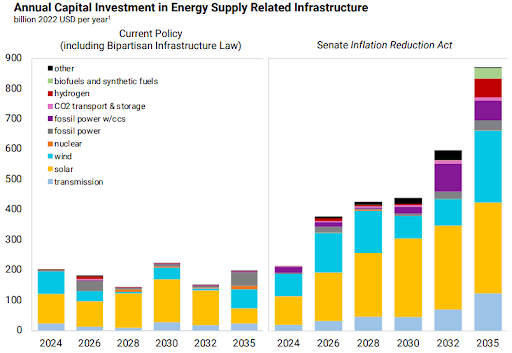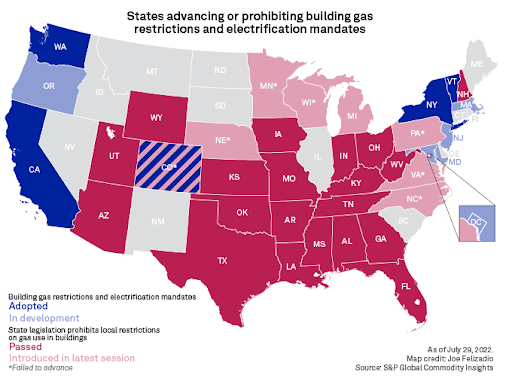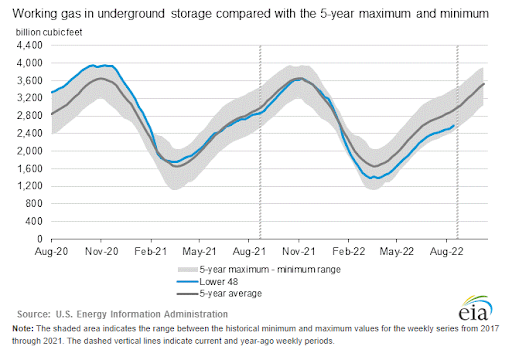Energy Markets Update
Weekly natural gas inventories
The U.S. Energy Information Administration reported last week that natural gas in storage increased by 60 Bcf. The five-year average injection for August is about 46 Bcf. Total U.S. natural gas in storage stood at 2,579 Bcf last week, 9.4% less than last year and 12.0% lower than the five-year average.
US power & gas update
- Gas prices have been hovering just under $10/MMBtu for the past two weeks. This highwater mark is a reflection of low storage numbers from last week as well as worsening European supply issues.
- Freeport LNG has delayed a partial operations restart until November at the earliest, keeping more supply in the US gas market for a bit longer. The export terminal has been offline since a fire in early June.
- Temperature forecasts have begun to drop across the US putting downward pressure on the natural gas market due to reduced cooling demand.
- Forward power markets across the country have followed the trend of natural gas with pricing creeping up across the board.
- For those in New England, the peak hour that will set everyone’s capacity tag for the next year looks to have occurred on July 20th hour ending 7pm (6-7 pm). This date and time are subject to change by ISO-NE, but this seems to be the one that will be used.
- Today's gas injection numbers came in at 60 Bcf, 9 higher than the analyst prediction of 51 Bcf.
 Source: Climate Prediction Center
Source: Climate Prediction Center
Gas market volatility continues
- European gas prices have risen sharply yet again due to a three day shutdown of the Russian Nord Stream pipeline.
- In addition to concerns about winter heating, several European countries are increasingly concerned about winter power supplies. France for example, historcally an exporter, is expected to become a power importer for this coming winter. This is largely a result of mismanagement of its own nuclear power fleet in recent years and couldn't have come at a worse time.
- Countries are racing to increase their LNG import capacity by chartering new floating storage regasification units (FSRUs) across a variety of areas such as Germany and the Netherlands.
- Meanwhile, American natural gas companies are looking to take advantage of high LNG demand, pushing forward large-scale LNG project expansions over the next few years.
- Less gas remaining in the US will translate into higher US prices over the long term. While it will take time to increase American LNG exports, markets have been jolted even in the near term. Near term gas prices reached nearly $10/MMBtu at the beginning of this week on the back of concerns about underperforming storage numbers. The gas drilling sector has been slow to rush into the market; a simple reaction to the losses incurred as a result of being overeager in 2018/2019.
- Freeport LNG’s restart has been delayed another month to November, causing a slight drop (~5%) in prices after the news broke. The plant was shut down early in the summer after a fire inflicted damage to the terminal.
Inflation Reduction Act to impact wide range of renewable generation projects
- President Biden signed the Inflation Reduction Act into law last Tuesday, creating nearly $400 billion in spending for decarbonization over the next ten years.
- For generation technology incentives, the IRA relies on production tax credits and investment tax credits for zero carbon electricity and most renewable energy builds. These are tried and tested mechanisms that will be increased and extended. However, there are a host of other related incentives for American-made products, advanced generation tech manufacturing, and for siting in brownfields and low-income communities.

- Wind generation is poised to see the most growth in terms of new generation additions by 2030 with the passing of the climate bill.
- Steve Piper, the director of energy research for S&P Global Market Intelligence, emphasized the importance of new tax credits for alternative generation sources such as hydrogen, geothermal, and nuclear power. It will take some time to observe which generation sources will be most impacted by the Inflation Reduction Act as they are developed.

Source: REPEAT Project, Princeton University - Before the passage of the IRA, S&P Global Commodity Insights forecasted that 62% of US electricity will be produced from zero-carbon sources by 2040. This number is expected to increase materially with the new law.
- High natural gas prices will likely keep coal generation alive in the short-term, but planned retirements of coal plants will phase out the most coal burn by 2030.
Small nuclear power poised to grow across US
-
Small modular nuclear reactors (SMRs) are expected to take off in the next few decades, providing 90 GW of new power capacity by 2050 according to the Nuclear Energy Institute (NEI).
- Several utilities surveyed by the NEI are considering installing SMRs at retired coal plants.
- Nuclear energy has been notoriously difficult to implement in the US. Costs have ballooned over the years and estimating them with any accuracy, even on multi-billion dollar projects, has proven to be guesswork. SMRs rely on many prefab core components, simplified designs, and once the industry gets off the ground, experienced installers. While the plants will be smaller, they are expected to shorten the construction cycle by as much as 50%.
- The first units are expected to be operational by 2030 in North America given efforts towards decarbonization.
- Industry experts expect increased interest with the passing of the Inflation Reduction Act, predicting investment to skyrocket once success of initial SMRs is seen.
Boston seeks to eliminate natural gas use in new construction
-
Boston is seeking to participate in a new Massachusetts program that allows cities to enforce a local natural gas ban in new buildings. The law itself was made possible by the passage of an omnibus climate bill in early August, House Bill 5060, An Act Driving Clean Energy and Offshore Wind.
- If successful, Boston would be the second biggest city in the Northeast to adopt such a ban after New York City.
- Mayor Michelle Wu is looking to expand fossil fuel-free energy sources that will provide jobs and other positive economic opportunities.
- Massachusetts hopes to attain a statewide goal of a 70% reduction in 1990 level fossil fuel emissions by 2030. The goal is to prevent emissions across the state from any new construction in cities that opt in to the program.
- Additionally, Boston is working on regulation for existing buildings to meet progressively stricter greenhouse gas limitation requirements, culminating in all buildings having zero carbon emissions by 2050.
- The following Massachusetts cities have already acquired local approval: Cambridge, Newton, Brookline, Lexington, Arlington, Concord, Lincoln, Acton, Aquinnah, and West Tisbury. To officially qualify, these towns must meet the affordable housing requirement outlined in the legislation.

Natural Gas Storage Data


Market Data
Use the filters to sort by region
Market data disclaimer: Data provided in the "Market Data" section is for the newsletter recipient only, and should not be shared with outside parties.



